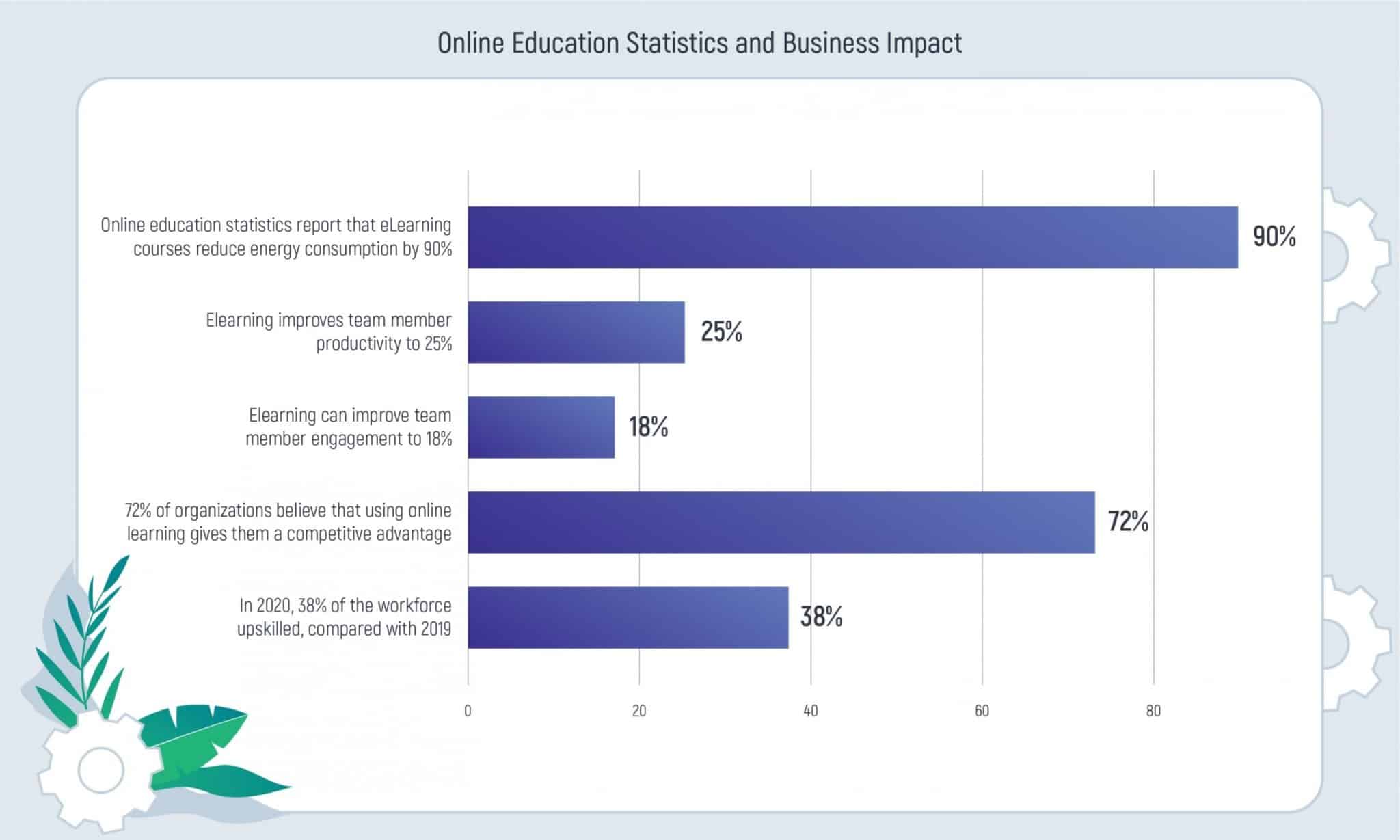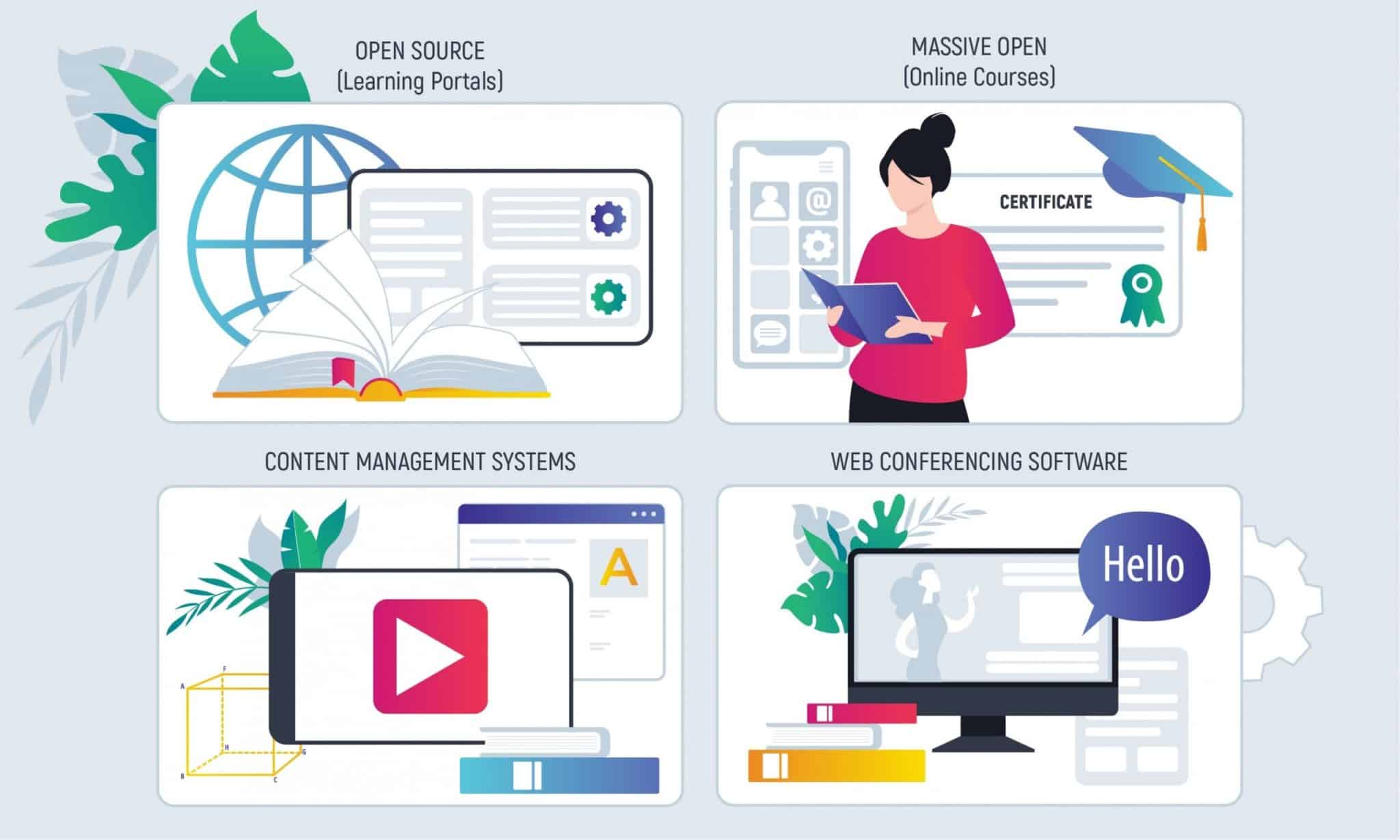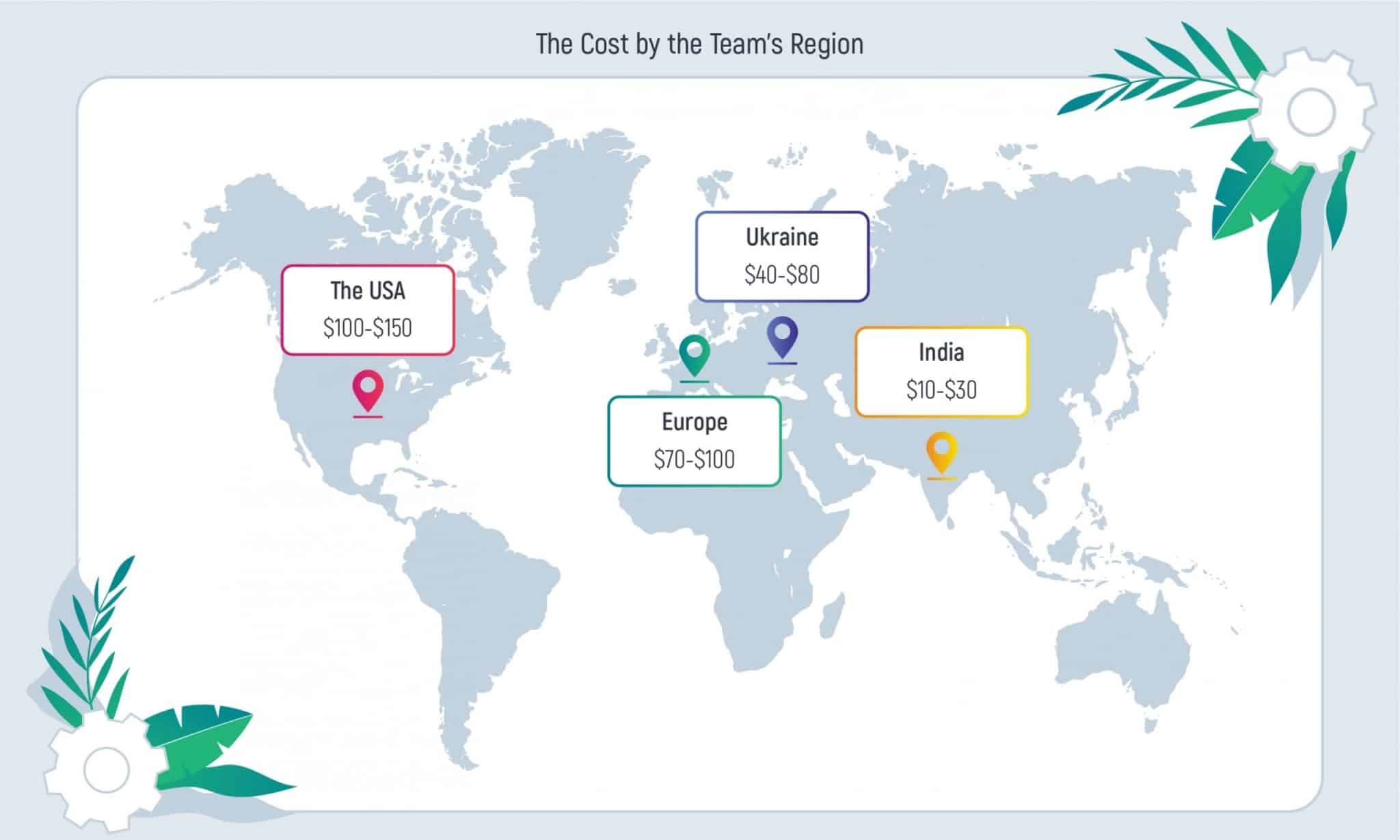In the digital era, the surge in remote learning has given rise to a flourishing e-learning market. Envision a world where education meets innovation, and your ideas have the potential to redefine the learning experience. Let's embark on this journey together, exploring the exciting landscape of e-learning and uncovering the steps to bring your vision to life.
Here's what you'll glean:
- Uncover the rewards of e-learning website development, from accessibility for all to personalized learning.
- Explore the target audience, including educational institutions and companies, making it a vital investment.
- Delve into diverse e-learning platforms like Learning Management Systems, Online Learning Marketplaces, and Online Course Platforms. Understand their nuances and choose the right path for your project.
- Follow a strategic roadmap in creating your e-learning platform, from idea validation and niche definition to choosing a business model and engaging educators.
- Navigate the technicalities of development, weighing costs, and ensuring quality. Explore the services offered by Inoxoft, a reliable partner for e-learning projects, ensuring satisfaction, speed, and top-notch quality.
Embark on the journey of building an impactful e-learning platform with insights that blend technical acumen and strategic prowess.
- What are the Benefits of Developing an E-learning Website and for Whom is It Needed?
- Types of E-learning Websites
- Learning Management System
- Online Learning Marketplace
- Online Course Platform
- The process of creating an online learning platform
- Validate your idea
- Define your niche
- Choose a business model
- Implement must-have features
- Choose the development approach
- Engage good educators
- How to develop e-learning website
- Summing Up
- Consider Inoxoft as a Reliable Partner for Building E-learning Projects
E-learning is an integral part of the education system nowadays. Since everything is working remotely, this market has significantly grown. It caused the appearance of new startups, and a lot of fresh ideas are innovative and have a lot to offer. Educational apps provide exciting content which keeps the learner engaged and devoted to the studying process. They gain so much popularity as they don’t require too much of your financial resources and time. Some e-learning platforms have already become real giants due to their influence on the market and importance in the educational world.
By creating an online learning platform, you open a lot of new opportunities for potential students. Moreover, it’s a great chance to show your creativity and make a statement in the educational field. This guide will tell you how to create an e-learning platform, what are the types of e-learning websites and how to develop an e-learning website. These easy tips will help you learn more about the industry and how to make your own contribution to it.
What are the Benefits of Developing an E-learning Website and for Whom is It Needed?
Creating e-learning website is not only a fun and interesting process, it’s also a really rewarding experience. It has a lot of benefits for you and your future customers. If you are going to build an e-learning website, you have to know all the pros of this idea. Online learning is beneficial due to its accessibility to all students, affordability regardless of their financial situation, and personalized learning according to a person’s needs. E-learning website development is important because now remote ways of learning take over and a lot of people decide to use modern technologies to get the proper education. The more applications the market has to offer, the better.
The main target audience for e-learning platforms is, of course, students. Schools and universities are now integrating online websites into traditional ways of teaching. That’s why e-learning website building is in high demand in this sphere. Companies that are targeted in the educational field should definitely consider e-learning platform development, as this is the best way to stay relevant in the market. Educational institutions benefit from modern technologies as well, as they boost the productivity of students, keep them fully in the process and allow them more creative. It’s a good thing for education in general, and this factor is essential for its ambassadors.
Types of E-learning Websites
Depending on one’s demand, there are different types of online learning websites that serve different purposes. They all are aimed at different target audiences and offer various content. Choosing your customers can play a decisive role in your business plan and alter your approach to how you develop an e-learning website. Here are some of the most popular types of e-learning platforms.
Learning Management System
The main purpose of this type of learning website is to train employees. Corporations and higher education institutions use this type the most often. Learning management systems allow employees and students to take part in live discussions and watch recorded lectures. Also, it is quite convenient for employees to always have access to all the necessary sources.
Online Learning Marketplace
Nowadays this type of online learning website has gained a lot of popularity. The main principle is that educators and students have the ability to connect and solve issues together. Video lessons and consultations are the base of this type of application and website. A student has an opportunity to choose a teacher he is interested in and ask him/her any questions he has. The video call can be individual or group, depending on your preference.
Online Course Platform
The online course platform offers you various video content from experts in areas you are interested in. You can choose an expert by reading reviews and comments from other users. If you complete the course successfully, you can receive certification. This type of online learning platform is also very popular, because you are in charge of who is your tutor, and it definitely boosts productivity.
As you can see, there are different types of online learning platforms, but they all can bring you the result you are looking for. Depending on what your target audience is and how you picture your project, you can choose the direction you want to develop your application in.
The process of creating an online learning platform
Now that you know what you want to achieve with your application, it’s time to figure out how to create an e-learning website. The process requires much of your devotion and attention to detail, but the result will be totally worth it. This short guide will help you get acquainted with the basic principles of website development and will tell you how to create an e-learning online platform.
Validate your idea
To properly validate your idea you have to look at the numbers. What is in demand on the market now? What are customers interested in? All this information will help you determine if the idea is worth investing money in. If you validate your idea properly, you will spend less time correcting your mistakes.
Define your niche
Think about the courses you will offer. You must be interested in the idea that you are developing, otherwise, the project will quickly become a burden to you. You already know the types of online e-learning platforms, so you can choose what speaks to you the most among all of them. Make sure your potential customers are looking for a specific type of application.
Choose a business model
When you have a great idea, now your task is to make it a reality. Of course, a creative approach is necessary if you want to create an e-learning website, but organizing your business is basically half of the deal. Choosing your business model you identify sources of revenue, products, details of financing, and the intended customer base. Your business model must be efficient and work for the company’s benefit.
Implement must-have features
Must-have features are the base of what makes an application worth attention. Your platform should be user-friendly and responsive to customers’ needs. Scalable text, search options, battery preservation, privacy options – all these things make your platform compatible with already renowned educational websites.
Choose the development approach
To make the process of development less stressful and complicated, you can choose the approach that suits you best. If you feel like you need help or if you are a newcomer, you can also attract experienced developers that can give you advice. Depending on your development approach, the speed of the process and how the development will be executed differs.
Engage good educators
This step is especially important if you are oriented at an online learning marketplace or online course platform. Engaging professionals demonstrate that your application is worth the trust. This step will help you get more customers and will guarantee a good reputation for your website. Moreover, if your application is developed enough, professionals will be eager to work with you.
Building an e-learning website is not an easy task. It is crucial to follow all the steps to make sure your platform is in demand on the market and can compete with other platforms. If you execute the process of creating successfully, the development stage will be much easier for you.
How to develop e-learning website
The development stage is technical at most, so it requires thorough research and readiness to plan every detail. First and foremost you should consider the cost of developing your online learning platform. The medium price of developing your website is $100, but it depends on the region you choose. Prices in the USA are the highest, in Europe and Eastern Europe are cheaper, and in Asia and India prices are the lowest. However, beware that reducing costs means reducing quality.
Specialists provide a lot of services to help you make your website more appealing and attractive for clients. With the help of professionals, you will get a visually stimulating design, high functionality of your platform, an intuitive interface, and cross-platform compatibility. All these services are important if you want to have a compatible website. However, don’t forget that development has to be revisited from time to time, so you could keep your project up-to-date.
Inoxoft is a company that provides the best development services for your project. Our clients can always rely on us for being devoted, creative, and responsible. If you contact us, be sure that your idea will be accepted and understood.
Summing Up
Insights:
-
Explosive Growth of E-learning Startups: The transition to remote learning has catalyzed the rapid growth of e-learning startups, leading to an influx of innovative ideas and solutions in the educational landscape. This surge in entrepreneurship underscores the dynamic nature of the e-learning market and its capacity for disruption, offering new avenues for creative expression and entrepreneurship within the educational sphere.
-
Accessibility and Affordability: E-learning platforms democratize access to education by offering flexible and affordable learning solutions to a diverse audience. By removing barriers related to geographical location, financial constraints, and time commitments, online learning platforms empower learners to pursue their educational goals at their own pace and convenience. This accessibility extends educational opportunities to underserved communities and individuals, fostering inclusivity and equity in education.
-
Personalized Learning Experience: One of the key advantages of e-learning platforms is their ability to deliver personalized learning experiences tailored to individual needs and preferences. Through adaptive learning algorithms and interactive content, online learning platforms cater to diverse learning styles and abilities, optimizing engagement and knowledge retention. This personalized approach enhances the effectiveness of learning interventions and promotes student-centered pedagogy in the digital age.
-
Convergence of Traditional and Digital Learning: Educational institutions are increasingly integrating online learning platforms into their traditional teaching methods, blurring the boundaries between physical and virtual learning environments. This convergence of traditional and digital learning modalities reflects a paradigm shift in educational delivery, driven by advancements in technology and changing student preferences. By embracing e-learning platforms, educational institutions can enhance the flexibility, accessibility, and scalability of their learning programs, enriching the overall learning experience for students.
-
Diverse Types of E-learning Platforms: E-learning platforms encompass a diverse range of formats and functionalities, catering to different learning objectives and target audiences. From learning management systems (LMS) designed for corporate training to online course platforms offering expert-led courses, the variety of e-learning platforms reflects the multifaceted nature of modern education. By understanding the unique features and capabilities of each type of e-learning platform, developers and educators can design customized learning experiences tailored to specific learning goals and preferences.
-
Holistic Approach to Platform Development: Building a successful e-learning platform requires a holistic approach encompassing market research, niche identification, business model selection, feature prioritization, and educator engagement. By systematically validating ideas, defining niches, and selecting appropriate business models, developers can align their platform development efforts with market demand and user needs, maximizing the chances of success in a competitive landscape.
-
Importance of User Experience and Design: User experience (UX) and design play a critical role in the success of e-learning platforms, influencing user engagement, retention, and satisfaction. Intuitive navigation, responsive design, and visually appealing interfaces are essential for creating a positive learning environment that fosters active participation and knowledge acquisition. By prioritizing UX and design considerations, developers can enhance the overall usability and effectiveness of their e-learning platforms, driving user adoption and loyalty.
-
Continuous Improvement and Innovation: The development of e-learning platforms is an iterative process that requires continuous improvement and innovation to stay relevant and competitive. By soliciting feedback from users, monitoring industry trends, and embracing emerging technologies, developers can adapt their platforms to evolving market dynamics and user preferences, ensuring long-term viability and success in the dynamic e-learning landscape.
-
Partnerships and Collaboration: Collaboration with educators, subject matter experts, and technology partners is essential for the success of e-learning platforms. By engaging educators in the platform development process, developers can ensure alignment with pedagogical principles and learning objectives, enhancing the quality and relevance of educational content. Moreover, partnerships with technology providers enable developers to leverage cutting-edge tools and resources, enriching the functionality and features of their e-learning platforms.
In conclusion, the development of e-learning platforms represents a transformative opportunity to revolutionize education and empower learners worldwide. By embracing innovation, collaboration, and user-centric design principles, developers can create immersive, engaging, and effective learning experiences that transcend traditional boundaries and unlock the full potential of online education.
Consider Inoxoft as a Reliable Partner for Building E-learning Projects
Online e-learning platform creation and development takes a lot of research and responsibility. To create the best learning website you need to determine what type of platform you want to develop, define your target audience, choose your business model and engage people who are willing to work with you.
Inoxoft is an outsourcing company that provides the best web development services for customers all around the world. Our main task is to make sure our customers are satisfied and their needs are fulfilled. You get fast performance, a devoted team, affordable prices, and, of course, a great quality of the result. We provide education software development services, LMS development services, school management software development, and creating an LMS management system from scratch. Providing all these services, we root for your business to thrive and make the process of development easy and enjoyable, offering reliability and a personalized approach.
Inoxoft is a company with great experience in the development field with a devoted team that is willing to meet all your business requirements. Contact us and create the online e-learning platform of your dream!
Frequently Asked Questions
What are the main types of e-learning platforms?
The main types of e-learning platforms are learning management system, online learning marketplace and online course platform. To know how each of these types function, read the article!
What is the cost of e-learning website building?
E-learning website builder should count on $100 as a middle price. Price varies depending on the region: in USA prices are the highest, in Asia and India - the lowest.
Who is the main target audience of e-learning websites?
The main target audience is, of course, students and teachers. However, online learning websites may be helpful for employees also.











